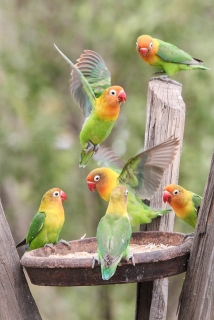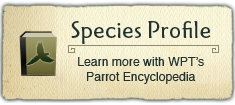Project Regions:
Fischer’s Lovebird |
|
|
Collaborators/Funders
NatureTanzania, Attraction Birds Conservation and the Tanzania BirdAtlas Project, BirdWatch Zambia, the Wildlife and Environment Society of Malawi, African Parks, the Malawi University of Science and Technology and Zambia Wildlife Authority, Pamela Isdell, the Parrot Society UK, Gesellschaft für Tropenornithologie e. V., Swissline cosmetics, International Foundation for Science and BirdLife International/Good Gifts catalogue, and the African Bird Club.
Fischer's Lovebird is threatened by persecution, a shrinking range and trapping.
Fischer's Lovebird has been heavily trafficked: from the 1980s to the 1990s over 500,000 individuals were trapped for the wild bird trade. Hybridisation with Masked Lovebirds may be of concern, and a reduction of nesting and foraging habitat is ongoing.
How WPT makes an impact: Beginning in 2021, WPT Lovebird Conservation Coordinator Sascha Düker led a review of research and conservation priorities for wild lovebirds. A main priority that emerged is a new survey of Fischer's Lovebird populations in Tanzania to assess the effects that both conservation measures, and trade and environmental change, have had on the species. The last population count was conducted nearly 30 years ago. Also in progress is genetic testing, which will determine the extent of hybridisation between Fischer's Lovebird and Masked Lovebird in Tanzania. A recent finding also revealed that persecution of these birds is more acute than previously thought, necessitating a thorough investigation.
Population: As few as 290,000 individuals.
Vital statistics: Size: 15cm (5.8 in) Weight: 42-58g (1.5-2 oz)
Range: Found in NC Tanzania, reaching E Rwanda and Burundi as an occasional visitor. Introduced to Tanga and Dar es Salaam, coastal Tanzania and at Mombasa, Nairobi, Athi River, Naivasha, and Isiolo, Kenya.
Natural history: These lovebirds are found from 1100 to 2200m (3608-7216 ft) in wooded grasslands with Acacia and Commiphora trees, savanna and in more open grasslands. They are also seen in agricultural areas and found in riverine woodland during the dry season. They eat grass seed, millet and maize, as well as seeds of Acacia, fallen berries and fruits. Fischers' are often found near water in small groups outside the breeding season, and where food is abundant will gather in more substantial flocks. Roosts in nest of Rufous-tailed Weaver. Breeding is from January-July; nest cavity in dead trees, also sometimes in cliffs.


































